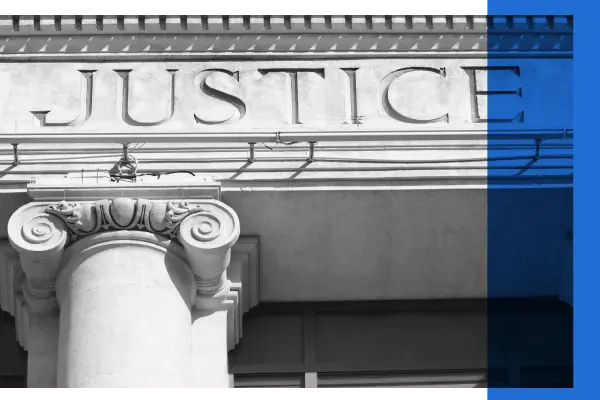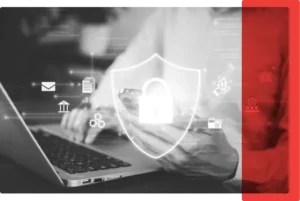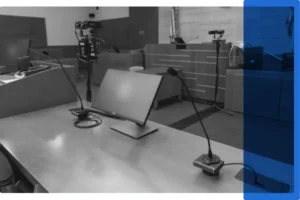
03 Mar
2023
Accepting the Paradigm Shift: Technology in the Legal Justice System
Adopting best practices for speech-to-text in the courtroom
Navigating a paradigm shift
A paradigm shift—a revolution in science, industry, or technology, originating from a disruptive discovery or force—always encounters opposition but results in irrevocable progress.
The legal justice system is amid a paradigm shift—a transition from relying on manual, time-consuming processes to incorporating technology that improves access, operations, and efficiency. While this may seem like an intuitive progression, the legal justice system, and courts in particular, have remained relatively unchanged for decades. During this paradigm shift, courts must anticipate some inevitable resistance to change. Moreover, courts must follow best practices for any newly implemented technology—not only to quell fears, but also to realize the full potential of their new platforms and equipment from day one.
Accelerated modernization
Throughout the COVID-19 pandemic, courts used emergency funding for technology—first to maintain, then to streamline operations. The implementation of digital hearings, audio-visual records, cloud-based storage, and speech-to-text draft transcripts did not end with the pandemic. Labor shortages, demand for modern conveniences, and the spread of technological acceptance—from one jurisdiction to the next—accelerated modernization.
Opposition to change
While many in the legal justice system embrace innovation, certain stakeholders—such as stenographers, who flourished under the established paradigm—perceive the new technology as a threat to their livelihood, rather than a tool at their disposal. This threat mindset produces a tendency to highlight supposed evidence of technological shortcomings. Moreover, it fosters a reluctance to examine the multitude of factors that contribute to the success or failure of any process, technology, or even person.
Attracting scrutiny
Of all the new technology supporting courts, speech-to-text has the most radical potential—from delivering same-day, draft transcripts to supplying real-time, searchable text during trials. Naturally, speech-to-text has attracted significant scrutiny. Stakeholders interested in preserving the status quo capitalize on any anomaly or unfavorable result to make inflammatory claims about speech-to-text platforms.
Yet, consider this: you cannot input the incorrect formula into a calculator, then point to an inaccurate answer as proof the calculator does not work. Nor can you require stenographers to wear earplugs in court and expect that they accurately record every muffled word. To achieve optimal results, whether with technology or people, you must understand the conditions necessary for success and strive to create them.
Best practices
Speech-to-text output depends on the equipment, audio engineering, and underlying platform; however, the human element plays a significant role in its courtroom functionality. The following best practices are critical to courts’ immediate and continuing success when selecting, implementing, and operating a speech-to-text platform.
1. Establish concrete goals for the technology
How do you define success for your speech-to-text installation? How do you intend to use it? For example:
- Does your judiciary want in-courtroom access to searchable text for review or read-back?
- Do you want to offer attorneys access to the platform for free or for a fee?
- Do you want to give deaf and hard-of-hearing people another accessibility option?
2. Use modern audio equipment
Clear audio is the foundation of accurate speech-to-text. Not all amplifiers, microphones, and/or mixers produce acceptable results. The latest generation of audio equipment captures sound better than the human ear at its peak performance; however, even some older equipment works with speech-to-text platforms if modified and programmed properly.
3. Customize audio systems to suit individual courtroom environments
Every courtroom has unique acoustics and distinctive background noise. Having audio engineers test, adjust, and optimize equipment in the actual space improves results.
4. Select a platform that links the text output with audio and video recordings
When used as intended, advanced speech-to-text platforms attain accuracy of up to 95%. Even with such results, audio and video recordings provide verification of accuracy, as well as insight into the speaker’s tone and expression. The audio and video are integral to the speech-to-text platform’s output and ultimate functionality.
5. Explain the purpose of the technology to staff
Speech-to-text platforms are not intended to replace people in the courtroom. These platforms are tools that can be used for the benefit of all participants. While features and benefits vary by platform, real-time speech-to-text technology allows judges to quickly review objections and related testimony. It connects remote teams of attorneys to live courtroom action, and it provides an additional accessibility option for people who need accommodations to participate.
6. Review courtroom operations
Prior to the implementation of any speech-to-text platform, courts should conduct a comprehensive business process review to understand, define, and document processes surrounding legal proceedings; from the initial case listing to when court proceedings are underway—and the capturing of the court record and relevant documentation throughout. This step allows administrators to:
- Identify how staff will interact with the technology
- Allocate responsibility and convey requirements for the operation of the system in the courtroom
- Understand how the platform will streamline certain manual tasks
- Develop a plan for redirecting resources
7. Train staff in how to operate the equipment
All staff members who currently support legal proceedings need to understand speech-to-text basics, and ideally, sign an acknowledgment of their ability to operate and/or work around the minimal, simple equipment. Staff members who have prominent courtroom speaking roles must agree to operate a microphone properly (speak into it, do not cover it, and do not unplug it). These individuals also need to be trained to remain with their designated microphone to enable speaker attribution in the text output.
8. Display clear signage in the courtroom
Courts need to display signage that:
- Highlights the use of speech-to-text and digital recording technology
- Offers access to this technology as a participation aid
- Provides basic operational instructions
- Includes a QR code for instant access
Speech-to-text technology in the courtroom gives people (especially people who are deaf or hard-of-hearing or who have cognitive processing delays) an accommodation option that enables meaningful participation without creating isolation.
9. Publicize the platform
As a taxpayer-funded, essential service with far-reaching effects, the public has a vested interest in the courts. Steps to improve efficiency, streamline operations, and modernize courtrooms ultimately enhance the public’s access to justice. Plus, technological improvements demonstrate a commitment to the whole community versus a commitment to the status quo.
Advocates, skeptics, and stakeholders
During any paradigm shift, there will be advocates and skeptics. There also will be stakeholders—with a vested interest in maintaining the established paradigm—who will contend that progress is the path to peril. Often, such stakeholders will present biased “evidence” that obfuscates reality and withholds critical information.
Scrutiny of speech-to-text platforms will escalate as the technological paradigm shift accelerates in courtrooms. Faced with claims that speech-to-text platforms will fail, consider the source and motivation. Also, consider there are baseline requirements for success, whether a process uses people or technology.
Create the conditions for success
Given the opportunity to succeed, speech-to-text platforms will reduce barriers to courtroom access; unlock immediate insights in the searchable court record; assist with labor shortages; provide the foundation for a certified transcript; enhance operational efficiencies; give court participants an additional accommodation option—and that is just the beginning. Speech-to-text is revolutionary technology poised to contribute so much to the legal justice system.
Learn more about FTR RealTime.



